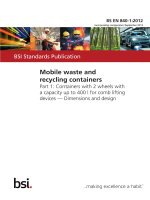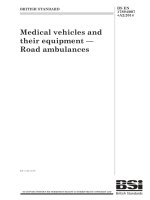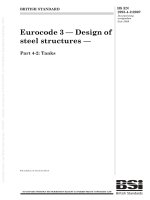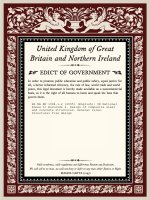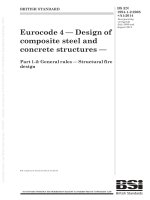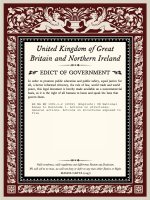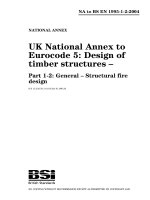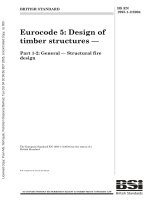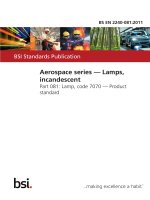Bsi bs en 61753 081 2 2014
Bạn đang xem bản rút gọn của tài liệu. Xem và tải ngay bản đầy đủ của tài liệu tại đây (1.25 MB, 22 trang )
BS EN 61753-081-2:2014
BSI Standards Publication
Fibre optic interconnecting
devices and passive
components — Performance
standard
Part 081-2: Non-connectorized single-mode
fibre optic middle-scale 1 x N DWDM devices
for category C — Controlled environments
BRITISH STANDARD
BS EN 61753-081-2:2014
National foreword
This British Standard is the UK implementation of EN 61753-081-2:2014. It
is identical to IEC 61753-081-2:2014.
The UK participation in its preparation was entrusted by Technical
Committee GEL/86, Fibre optics, to Subcommittee GEL/86/2, Fibre optic
interconnecting devices and passive components.
A list of organizations represented on this committee can be obtained on
request to its secretary.
This publication does not purport to include all the necessary provisions of
a contract. Users are responsible for its correct application.
© The British Standards Institution 2014.
Published by BSI Standards Limited 2014
ISBN 978 0 580 81976 6
ICS 33.180.10
Compliance with a British Standard cannot confer immunity from
legal obligations.
This British Standard was published under the authority of the
Standards Policy and Strategy Committee on 30 September 2014.
Amendments/corrigenda issued since publication
Date
Text affected
BS EN 61753-081-2:2014
EUROPEAN STANDARD
EN 61753-081-2
NORME EUROPÉENNE
EUROPÄISCHE NORM
August 2014
ICS
English Version
Fibre optic interconnecting devices and passive components Performance standard - Part 081-2: Non-connectorized singlemode fibre optic middle-scale 1 x N DWDM devices for category
C - Controlled environments
(IEC 61753-081-2:2014)
Dispositifs d'interconnexion et composants passifs à fibres
optiques - Norme de performance - Partie 081-2: Dispositifs
DWDM 1 x N de milieu d'échelle à fibres optiques
unimodales, non connectorisés, pour catégorie C Environnements contrôlés
(CEI 61753-081-2:2014)
Lichtwellenleiter - Verbindungselemente und passive
Bauteile - Betriebsverhalten - Teil 081-2: Nicht mit
Steckverbinder versehene mittelgroße EinmodenLichtwellenleiter-1-x-N-DWDM-Bauteile für die Kategorie C
- Kontrollierte Umgebung
(IEC 61753-081-2:2014)
This European Standard was approved by CENELEC on 2014-05-29. CENELEC members are bound to comply with the CEN/CENELEC
Internal Regulations which stipulate the conditions for giving this European Standard the status of a national standard without any alteration.
Up-to-date lists and bibliographical references concerning such national standards may be obtained on application to the CEN-CENELEC
Management Centre or to any CENELEC member.
This European Standard exists in three official versions (English, French, German). A version in any other language made by translation
under the responsibility of a CENELEC member into its own language and notified to the CEN-CENELEC Management Centre has the
same status as the official versions.
CENELEC members are the national electrotechnical committees of Austria, Belgium, Bulgaria, Croatia, Cyprus, the Czech Republic,
Denmark, Estonia, Finland, Former Yugoslav Republic of Macedonia, France, Germany, Greece, Hungary, Iceland, Ireland, Italy, Latvia,
Lithuania, Luxembourg, Malta, the Netherlands, Norway, Poland, Portugal, Romania, Slovakia, Slovenia, Spain, Sweden, Switzerland,
Turkey and the United Kingdom.
European Committee for Electrotechnical Standardization
Comité Européen de Normalisation Electrotechnique
Europäisches Komitee für Elektrotechnische Normung
CEN-CENELEC Management Centre: Avenue Marnix 17, B-1000 Brussels
© 2014 CENELEC All rights of exploitation in any form and by any means reserved worldwide for CENELEC Members.
Ref. No. EN 61753-081-2:2014 E
BS EN 61753-081-2:2014
EN 61753-081-2:2014
-2-
Foreword
The text of document 86B/3646/CDV, future edition 2 of IEC 61753-081-2, prepared by SC 86B "Fibre
optic interconnecting devices and passive components" of IEC/TC 86 "Fibre optics" was submitted to
the IEC-CENELEC parallel vote and approved by CENELEC as EN 61753-081-2:2014.
The following dates are fixed:
–
latest date by which the document has to be implemented at
national level by publication of an identical national
standard or by endorsement
(dop)
2015-03-01
–
latest date by which the national standards conflicting with
the document have to be withdrawn
(dow)
2017-05-29
Attention is drawn to the possibility that some of the elements of this document may be the subject of
patent rights. CENELEC [and/or CEN] shall not be held responsible for identifying any or all such
patent rights.
Endorsement notice
The text of the International Standard IEC 61753-081-2:2014 was approved by CENELEC as a
European Standard without any modification.
-3-
BS EN 61753-081-2:2014
EN 61753-081-2:2014
Annex ZA
(normative)
Normative references to international publications
with their corresponding European publications
The following documents, in whole or in part, are normatively referenced in this document and are
indispensable for its application. For dated references, only the edition cited applies. For undated
references, the latest edition of the referenced document (including any amendments) applies.
NOTE 1 When an International Publication has been modified by common modifications, indicated by (mod), the relevant
EN/HD applies.
NOTE 2 Up-to-date information on the latest versions of the European Standards listed in this annex is available here:
www.cenelec.eu.
Publication
IEC 60793-2-50
Year
2012
IEC 60794-2-50
-
IEC 61300-2-1
-
IEC 61300-2-4
-
IEC 61300-2-9
-
IEC 61300-2-14
-
IEC 61300-2-17
-
IEC 61300-2-18
-
IEC 61300-2-19
-
IEC 61300-2-22
-
IEC 61300-2-42
-
Title
EN/HD
Optical fibres -- Part 2-50: ProductEN 60793-2-50
specifications - Sectional specification for
class B single-mode fibres
Optical fibre cables -- Part 2-50: IndoorEN 60794-2-50
cables - Family specification for simplex
and duplex cables for use in terminated
cable assemblies
Fibre optic interconnecting devices andEN 61300-2-1
passive components - Basic test and
measurement procedures -- Part 2-1:
Tests - Vibration (sinusoidal)
Fibre optic interconnecting devices andEN 61300-2-4
passive components - Basic test and
measurement procedures -- Part 2-4:
Tests - Fibre/cable retention
Fibre optic interconnecting devices andEN 61300-2-9
passive components - Basic test and
measurement procedures -- Part 2-9:
Tests - Shock
+AC
Fibre optic interconnecting devices andEN 61300-2-14
passive components - Basic test and
measurement procedures -- Part 2-14:
Tests - High optical power
Fibre optic interconnecting devices andEN 61300-2-17
passive components - Basic test and
measurement procedures -- Part 2-17:
Tests - Cold
Fibre optic interconnecting devices andEN 61300-2-18
passive components - Basic test and
measurement procedures -- Part 2-18:
Tests - Dry heat - High temperature
endurance
Fibre optic interconnecting devices andEN 61300-2-19
passive components - Basic test and
measurement procedures -- Part 2-19:
Tests - Damp heat (steady state)
Fibre optic interconnecting devices andEN 61300-2-22
passive components - Basic test and
measurement procedures -- Part 2-22:
Tests - Change of temperature
Fibre optic interconnecting devices andEN 61300-2-42
passive components - Basic test and
measurement procedures -- Part 2-42:
Tests - Static side load for strain relief
Year
2013
-
-
-
-
2011
-
-
-
-
-
-
BS EN 61753-081-2:2014
EN 61753-081-2:2014
IEC 61300-3-2
-
IEC 61300-3-6
-
IEC 61300-3-20
-
IEC 61300-3-29
-
IEC 61300-3-32
-
IEC 61300-3-38
-
IEC 61753-021-2
-
IEC 62074-1
-
ITU
series
-4Fibre optic interconnecting devices andEN 61300-3-2
passive components - Basic test and
measurement procedures -- Part 3-2:
Examinations and measurements Polarization dependent loss in a singlemode fibre optic device
Fibre optic interconnecting devices andEN 61300-3-6
passive components - Basic test and
measurement procedures -- Part 3-6:
Examinations and measurements - Return
loss
Fibre optic interconnecting devices andEN 61300-3-20
passive components - Basic test and
measurement procedures -- Part 3-20:
Examinations and measurements Directivity of fibre optic branching devices
+EN
61300-3-2002
20:2001/corrigendum
Mar. 2002
Fibre optic interconnecting devices andEN 61300-3-29
passive components - Basic test and
measurement procedures -- Part 3-29:
Examinations and measurements Spectral transfer characteristics of DWDM
devices
Fibre optic interconnecting devices andEN 61300-3-32
passive components - Basic test and
measurement procedures -- Part 3-32:
Examinations and measurements Polarisation
mode
dispersion
measurement
for
passive
optical
components
Fibre optic interconnecting devices andEN 61300-3-38
passive components - Basic test and
measurement procedures -- Part 338:Examinations and measurements Group delay, chromatic dispersion and
phase ripple
Fibre optic interconnecting devices andEN 61753-021-2
passive
components
performance
standard -- Part 021-2: Grade C/3 singlemode fibre optic connectors for category C
- Controlled environment
Fibre optic interconnecting devices andEN 62074-1
passive components - Fibre optic WDM
devices -- Part 1: Generic specification
Pulse code modulation (PCM) of voiceseries
frequencies
–2–
BS EN 61753-081-2:2014
IEC 61753-081-2:2014 © IEC 2014
CONTENTS
1
Scope .............................................................................................................................. 5
2
Normative references ...................................................................................................... 5
3
Terms and definitions ...................................................................................................... 6
4
Test conditions – General ................................................................................................ 7
5
Test report ....................................................................................................................... 7
6
Reference components .................................................................................................... 7
7
Performance requirements .............................................................................................. 8
7.1
Dimensions ............................................................................................................. 8
7.2
Test details and requirements ................................................................................. 8
Annex A (normative) Sample size ........................................................................................ 16
Bibliography .......................................................................................................................... 17
Table 1 – Spectral bands for single-mode systems a .............................................................. 7
Table 2 – Test and requirements for type A (Gaussian passband profile) ................................ 8
Table 3 – Test and requirements for type B (Flat-top passband profile) ................................. 11
Table 4 – Environmental test for all types ............................................................................. 14
Table A.1 – Sample size ....................................................................................................... 16
BS EN 61753-081-2:2014
IEC 61753-081-2:2014 © IEC 2014
–5–
FIBRE OPTIC INTERCONNECTING DEVICES
AND PASSIVE COMPONENTS –
PERFORMANCE STANDARD –
Part 081-2: Non-connectorized single-mode fibre optic middle-scale
1 × N DWDM devices for category C – Controlled environments
1
Scope
This part of IEC 61753 contains the minimum initial test and measurement requirements and
severities which a fibre optic middle-scale 1 × N (16 ≤N ≤64) DWDM (dense wavelength
division multiplexing) device with channel spacing of 50 GHz, 100 GHz or 200 GHz needs to
satisfy in order to be categorized as meeting the requirements of category C – Controlled
environment. The requirements are given for the DWDM devices with Gaussian passband
profile and flat-top passband profile. The requirements cover devices with single-mode nonconnectorized pigtails and no circuit board.
2
Normative references
The following documents, in whole or in part, are normatively referenced in this document and
are indispensable for its application. For dated references, only the edition cited applies. For
undated references, the latest edition of the referenced document (including any
amendments) applies.
IEC 60793-2-50:2012, Optical fibres – Part 2-50: Product specifications – Sectional
specification for class B single-mode fibres
IEC 60794-2-50, Optical fibre cables – Part 2-50: Indoor cables – Family specification for
simplex and duplex cables for use in terminated cable assemblies
IEC 61300-2-1, Fibre optic interconnecting devices and passive components – Basic test and
measurement procedures – Part 2-1: Tests – Vibration (sinusoidal)
IEC 61300-2-4, Fibre optic interconnecting devices and passive components – Basic test and
measurement procedures – Part 2-4: Tests – Fibre/cable retention
IEC 61300-2-9, Fibre optic interconnecting devices and passive components – Basic test and
measurement procedures – Part 2-9: Tests – Shock
IEC 61300-2-14, Fibre optic interconnecting devices and passive components – Basic test
and measurement procedures – Part 2-14: Tests – High optical power
IEC 61300-2-17, Fibre optic interconnecting devices and passive components – Basic test
and measurement procedures – Part 2-17: Tests – Cold
IEC 61300-2-18, Fibre optic interconnecting devices and passive components – Basic test
and measurement procedures – Part 2-18: Tests – Dry heat – High temperature endurance
IEC 61300-2-19, Fibre optic interconnecting devices and passive components – Basic test
and measurement procedures – Part 2-19: Tests – Damp heat (steady state)
–6–
BS EN 61753-081-2:2014
IEC 61753-081-2:2014 © IEC 2014
IEC 61300-2-22, Fibre optic interconnecting devices and passive components – Basic test
and measurement procedures – Part 2-22: Tests – Change of temperature
IEC 61300-2-42, Fibre optic interconnecting devices and passive components – Basic test
and measurement procedures – Part 2-42: Tests – Static side load for connectors
IEC 61300-3-2, Fibre optic interconnecting devices and passive components – Basic test and
measurement procedures – Part 3-2: Examinations and measurements – Polarization
dependence of attenuation in a a single-mode fibre optic device
IEC 61300-3-6, Fibre optic interconnecting devices and passive components – Basic test and
measurement procedures – Part 3-6: Examinations and measurements – Return loss
IEC 61300-3-20, Fibre optic interconnecting devices and passive components – Basic test
and measurement procedures – Part 3-20: Examinations and measurements – Directivity of
fibre optic branching devices
IEC 61300-3-29, Fibre optic interconnecting devices and passive components – Basic test
and measurement procedures – Part 3-29: Examinations and measurements – Measurement
techniques for characterizing the amplitude of the spectral transfer function of DWDM
components
IEC 61300-3-32, Fibre optic interconnecting devices and passive components – Basic test
and measurement procedures – Part 3-32: Examinations and measurements – Polarization
mode dispersion measurement for passive optical components
IEC 61300-3-38, Fibre optic interconnecting devices and passive components – Basic test
and measurement procedures – Part 3-38: Examinations and measurements – Group delay,
chromatic dispersion and phase ripple
IEC 61753-021-2, Fibre optic interconnecting devices and passive components performance
standard – Part 021-2: Fibre optic connectors terminated on single mode fibre for category C
–Controlled environment
IEC 62074-1, Fibre optic WDM devices – Part 1: Generic specification
ITU-T Recommendation G series – Supplement 39, Optical system design and engineering
considerations
ITU-T Recommendation G.692, Optical interfaces for multichannel systems with optical
amplifiers
ITU-T Recommendation G.694.1, Spectral grids for WDM applications: DWDM frequency grid
3
Terms and definitions
For the purposes of this document, the following terms and definitions, as well as those given
in IEC 62074-1, apply.
3.1
middle-scale 1 × N DWDM device
wavelength-selective branching device which performs the function both of a wavelength
multiplexer and demultiplexer with DWDM channel spacing of 50 GHz, 100 GHz or 200 GHz
and a number of channels (N) equalling 16 ~ 64
BS EN 61753-081-2:2014
IEC 61753-081-2:2014 © IEC 2014
–7–
3.2
type A (Gaussian passband profile)
middle-scale 1 × N DWDM device whose passband profile is Gaussian shape
3.3
type B (Flat-top passband profile)
middle-scale 1 × N DWDM device whose passband profile is flat-top shape
4
Test conditions – General
Unless otherwise specified, all test methods shall be in accordance with the IEC 61300 series.
The samples shall be terminated onto single-mode fibres as per IEC 60793-2-50:2012
category B1.1 or B1.3 or B6 in either coated fibres (primary and secondary) or reinforced
cable format as per IEC 60794-2-50. DWDM devices used for each test are intended to be
previously unstressed new samples but may also be selected from previously used samples, if
desired. All measurements shall be carried out at normal room temperature, unless otherwise
stated. If the device is provided with an active temperature control, this shall be set at the setpoint specified by the manufacturer.
The requirements apply to every combination of input and output port.
All tests shall be carried out to validate performance over the required operating wavelength
range. As a result, single or multiple spectral bands may be chosen for the qualification and
differing target specifications may be assigned to each spectral band.
The following Table 1 is intended to provide guidance on the wavelength ranges of the
various spectral bands. It is not intended for specification. Values of operating wavelength
used in performance verification shall be defined in the manufacturer’s specification.
Table 1 – Spectral bands for single-mode systems
a
5
a
Band
Descriptor
Range
nm
O-band
Original
1 260 to 1 360
E-band
Extended
1 360 to 1 460
S-band
Short wavelength
1 460 to 1 530
C-band
Conventional
1 530 to 1 565
L-band
Long wavelength
1 565 to 1 625
U-band
Ultralong wavelength
1 625 to 1 675
Taken from ITU-T G-series Recommendations – Supplement 39, Optical system design and engineering
considerations
Test report
Fully documented test reports and supporting evidence shall be prepared and be available for
inspection as evidence that the tests have been carried out and complied with.
6
Reference components
The testing for these components does not require the use of reference components.
–8–
7
BS EN 61753-081-2:2014
IEC 61753-081-2:2014 © IEC 2014
Performance requirements
7.1
Dimensions
Dimensions shall comply with those given in appropriate manufacturers’ drawings.
7.2
Test details and requirements
The device is equipped with no circuit-board including a temperature controller. The
requirements are given only for pigtailed DWDM devices. For connectorized components, the
connector performances shall be in compliance with IEC 61753-021-2.
A minimum length of fibre or cable of2,0 m per port shall be included in all climatic and
environmental tests. The operating wavelengths, unless otherwise specified, shall be in
accordance with ITU-T Recommendation G.692 and G.694.1. Where devices with wavelength
spaced channels have to be considered, the conversion should refer to vacuum wavelength.
Table 2 – Test and requirements for type A (Gaussian passband profile)
No
1A
2A
Tests
Number of
channels: N
Channel
frequency range
Requirements
16 ≤ N ≤64
Channel central frequency
± 0,125 × ∆f where ∆f is
the channel spacing
Details
Operating
wavelength:
ITU-T grid or custom design
NOTE:
Design information (not test item)
Channel central
frequency:
ITU-T grid or custom design
NOTE:
Design information (not test item)
ITU-T Recommendation G.694.1
3A
4A
5A
6A
Attenuation
(insertion loss)
≤ 4,3 dB
(channel n° ≤ 24)
Launch fibre
length:
≥ 2,0 m
IEC 61300-3-29
≤ 4,8 dB
(channel n° > 24)
Measurement
uncertainty:
± 0,05 dB
Maximum allowable
insertion loss over the
channel frequency range
NOTE:
The insertion loss is determined as
the worst case over all states of
polarization
Channel nonuniformity
≤ 1,0 dB
(channel n°. ≤24)
Launch fibre
length:
≥ 2,0 m
IEC 61300-3-29
≤ 1,5 dB
(channel n° >24)
Measurement
uncertainty:
± 0,05 dB
Maximum allowable
channel non-uniformity of
insertion losses
NOTE:
The channel non-uniformity shall be
determined as the worst case over
all states of polarization
1 dB passband
width
≥ 0,25 × ∆f where ∆f is
the channel spacing.
Launch fibre
length:
≥ 2,0 m
IEC 61300-3-29
Minimum allowable 1 dB
passband width (centred
at the channel frequency)
Measurement
uncertainty:
± 0,01 × ∆f
NOTE:
The 1 dB passband width shall be
determined as the worst case over
all states of polarization
3 dB passband
width
≥ 0,5 × ∆f where ∆f is
the channel spacing
Launch fibre
length:
≥ 2,0 m
IEC 61300-3-29
Minimum allowable 3 dB
passband width (centred
at the channel frequency)
Measurement
uncertainty:
± 0,01 × ∆f
NOTE:
The 3 dB passband width is
determined as the worst case over
all states of polarization
BS EN 61753-081-2:2014
IEC 61753-081-2:2014 © IEC 2014
–9–
Table 2 (continued)
No
7A
Tests
Passband
ripple
IEC 61300-329
8A
Adjacent
channel
crosstalk
IEC 61300-329
Requirements
≤ 1,5 dB
Maximum insertion loss
variation within the
channel frequency range
≤ –25 dB
Maximum allowable
adjacent channel
crosstalk over the
channel frequency range
Details
Launch fibre
length:
≥ 2,0 m
Measurement
uncertainty:
± 0,05 dB
NOTE:
The passband ripple is determined
as the worst case over all states of
polarization.
Launch fibre
length:
≥ 2,0 m
Measurement
uncertainty:
± 0,1 dB
NOTE:
The adjacent channel crosstalk is
specified only for demultiplexer.
The adjacent channel crosstalk is
determined as the worst case over
all states of polarization
9A
Non-adjacent
channel
crosstalk
IEC 61300-329
≤ –30 dB
Maximum allowable nonadjacent channel
crosstalk over the channel
frequency range
Launch fibre
length:
≥ 2,0 m
Measurement
uncertainty:
± 0,1 dB
NOTE:
The non-adjacent channel crosstalk
is specified only for demultiplexer.
The non-adjacent channel crosstalk
is determined as the worst case
over all states of polarization
10A
Total channel
crosstalk
IEC 61300-329
≤ –22 dB (channel n° ≤40)
≤ –20 dB (channel n°
>40)
Maximum allowable total
channel crosstalk value
Launch fibre
length:
≥ 2,0 m
Measurement
uncertainty:
± 0,1 dB
NOTE:
The total channel crosstalk is
specified only for demultiplexer.
The total channel crosstalk is
determined as the worst case over
all states of polarization
11A
Polarization
dependent loss
(PDL)
IEC 61300-3-2
12A
Polarization
mode
dispersion
(PMD)
IEC 61300-332
≤ 0,4 dB
Maximum allowable
PDL over the channel
frequency range
≤.0,5 ps
Maximum allowable PMD
over the channel
frequency range
Launch fibre
length:
≥ 2,0 m
Measurement
uncertainty:
± 0,05 dB
NOTE:
The allowable PDL combination
applies to all combination of input
and output ports
Launch fibre
length:
≥.2,0 m
Measurement
uncertainty:
±.0,1 dB
NOTE:
The allowable PMD combination
applies to all combination of input
and output ports.
– 10 –
BS EN 61753-081-2:2014
IEC 61753-081-2:2014 © IEC 2014
Table 2 (continued)
No
Tests
13A
Chromatic
dispersion (CD)
≤ 20 ps/nm for 100 GHz
channel spacing
Launch fibre
length:
≥ 2,0 m
IEC 61300-3-38
≤ 60 ps/nm for 50 GHz
channel spacing
Measurement
uncertainty:
± 1 ps
Maximum allowable CD
over the channel
frequency range
(absolute value)
NOTE:
The allowable CD combination
applies to all combination of input
and output ports.
Return loss
≥ 40 dB
≥ 2,0 m
IEC 61300-3-6
Minimum allowable
return loss
Launch fibre
length:
Measurement
uncertainty:
± 1 dB
NOTE:
All ports not under test is terminated
to avoid unwanted reflections
contributing to the measurement.
Launch fibre
length:
≥ 2,0 m
Measurement
uncertainty:
± 1 dB
NOTE:
All ports not under test shall be
terminated to avoid unwanted
reflections contributing to the
measurement.
14A
15A
Requirements
Directivity
≥ 40 dB
IEC 61300-3-20
Minimum allowable
directivity
Details
The directivity is measured between
any pair of input or output ports
16A
High optical
power
IEC 61300-2-14
Before and after the test,
the limits of insertion
loss and return loss of
test 3A and 14A shall be
met.
During the test, the
insertion loss change is
monitored. During and
after the test, the
insertion loss change
shall be within ±0,3 dB
of the initial value.
During the test, the
return loss change is
monitored. The sum of
the initial value and the
change of the return loss
shall be within the value
defined at test 14A
Optical power:
300 mW
Wavelength:
1 550 nm
Duration of the
optical power
exposure:
30 min
Temperature:
60 °C ± 2° C
Relative humidity:
+2
93 − 3 % RH
Input port:
Single input port
Measurement
uncertainty:
± 0,05 dB for insertion loss
measurement
± 1 dB for return loss measurement
BS EN 61753-081-2:2014
IEC 61753-081-2:2014 © IEC 2014
– 11 –
Table 3 – Test and requirements for type B (Flat-top passband profile)
No
1B
2B
Tests
Requirements
Number of
channels
16 ≤ channel n° ≤64
Channel
frequency
range
Channel central
frequency ± 0,125 × ∆f
where ∆f is the channel
spacing
Details
Operating
wavelength:
ITU-T grid or custom design
NOTE:
Design information (not test item)
Channel central
frequency:
ITU-T grid or custom design
NOTE:
Design information (not test item)
ITU-T Recommendation G.694.1
3B
4B
5B
6B
7B
Attenuation
Insertion loss
≤5,5 dB
(channel n° ≤24)
Launch fibre
length:
≥ 2,0 m
IEC 61300-329
≤6,0 dB
(channel n° >24)
Measurement
uncertainty:
± 0,05 dB
Maximum allowable
insertion loss over the
channel frequency range
NOTE:
The insertion loss is determined as
the worst case over all states of
polarization.
Channel nonuniformity
≤1,0 dB
(channel n° ≤24)
Launch fibre
length:
≥ 2,0 m
IEC 61300-329
≤1,5 dB
(channel n° >24)
Measurement
uncertainty:
± 0,05 dB
Maximum allowable
channel non-uniformity
of insertion losses
NOTE:
The channel non-uniformity is
determined as the worst case over
all states of polarization.
1 dB passband
width
≥ 0,5 × ∆f where ∆f is
the channel spacing
Launch fibre
length:
≥ 2,0 m
IEC 61300-329
Minimum allowable 1 dB
passband width (centred
at the channel
frequency)
Measurement
uncertainty:
± 0,01 × ∆f
NOTE:
The 1 dB passband width is
determined as the worst case over
all states of polarization.
3 dB passband
width
≥ 0,5 × ∆f where ∆f is
the channel spacing
Launch fibre
length:
≥ 2,0 m
IEC 61300-329
Minimum allowable 3 dB
passband width (centred
at the channel
frequency)
Measurement
uncertainty:
± 0,01 × ∆f
NOTE:
The 3 dB passband width is
determined as the worst case over
all states of polarization.
≤ 0,5 dB
Launch fibre
length:
≥ 2,0 m
Measurement
uncertainty:
± 0,05 dB
NOTE:
The passband ripple is determined
as the worst case over all states of
polarization.
Launch fibre
length:
≥ 2,0 m
Measurement
uncertainty:
± 0,1 dB
NOTE:
The adjacent channel crosstalk is
specified only for demultiplexer.
Passband
ripple
IEC 61300-329
8B
Adjacent
channel
crosstalk
IEC 61300-3-29
Maximum insertion loss
variation within the
channel frequency range
≤ -25 dB
Maximum allowable
adjacent channel
crosstalk over the
channel frequency range
The adjacent channel crosstalk is
determined as the worst case over
all states of polarization.
– 12 –
BS EN 61753-081-2:2014
IEC 61753-081-2:2014 © IEC 2014
Table 3 (continued)
No
9B
Tests
Non-adjacent
channel
crosstalk
IEC 61300-3-29
Requirements
≤ –30 dB
Maximum allowable nonadjacent channel
crosstalk over the
channel frequency range
Details
Launch fibre
length:
≥ 2,0 m
Measurement
uncertainty:
± 0,1 dB
NOTE:
The non-adjacent channel crosstalk
is specified only for demultiplexer.
The non-adjacent channel crosstalk
is determined as the worst case over
all states of polarization.
10B
Total channel
crosstalk
≤ –22 dB
(channel n° ≤40)
Launch fibre
length:
≥ 2,0 m
IEC 61300-3-29
≤ –20 dB
(channel n° >40)
Measurement
uncertainty:
± 0,1 dB
Maximum allowable total
channel crosstalk value
NOTE:
The total channel crosstalk is
specified only for demultiplexer.
The total channel crosstalk is
determined as the worst case over
all states of polarization.
11B
Polarization
dependent loss
(PDL)
IEC 61300-3-2
12B
Polarization
mode
dispersion
(PMD)
IEC 61300-3-32
13B
14B
≤ 0,4 dB
Maximum allowable PDL
over the channel
frequency range
≤ 0,5 ps
Maximum allowable
PMD over the channel
frequency range
Launch fibre
length:
≥ 2,0 m
Measurement
uncertainty:
± 0,05 dB
NOTE:
The allowable PDL combination
applies to all combination of input
and output ports.
Launch fibre
length:
≥ 2,0 m
Measurement
uncertainty:
± 0,1 dB
NOTE:
The allowable PMD combination
applies to all combination of input
and output ports.
≥ 2,0 m
Chromatic
dispersion (CD)
≤ 40 ps/nm for 100 GHz
channel spacing
Launch fibre
length:
IEC 61300-3-38
≤ 100 ps/nm for 50 GHz
channel spacing
Measurement
uncertainty:
Maximum allowable CD
over the channel
frequency range
(absolute value)
NOTE:
Return loss
≥ 40 dB
IEC 61300-3-6
Minimum allowable
return loss
Launch fibre
length:
Measurement
uncertainty:
NOTE:
± 1 ps
The allowable CD combination
applies to all combination of input
and output ports.
≥ 2,0 m
± 1 dB
All ports not under test is terminated
to avoid unwanted reflections
contributing to the measurement.
BS EN 61753-081-2:2014
IEC 61753-081-2:2014 © IEC 2014
– 13 –
Table 3 (continued)
No
15B
Tests
Requirements
Directivity
≥ 40 dB
IEC 61300-3-20
Minimum allowable
directivity
Details
Launch fibre
length:
≥ 2,0 m
Measurement
uncertainty:
± 1 dB
NOTE:
All ports not under test is terminated
to avoid unwanted reflections
contributing to the measurement.
The directivity is measured between
any pair of input or output ports
16B
High optical
power
IEC 61300-2-14
Before and after the
test, the limits of
insertion loss and return
loss of test n° 3B and
14B shall be met.
During the test, the
insertion loss change is
monitored. During and
after the test, the
insertion loss change
shall be within ±0,5 dB
of the initial value.
During the test, the
return loss change is
monitored. The sum of
the initial value and the
change of the return
loss shall be within the
value defined at test
14B
Optical power:
300 mW
Wavelength:
1 550 nm
Duration of the
optical power
exposure:
30 min
Temperature:
60 °C ± 2 ° C
Relative humidity:
+2
93 − 3 % RH
Input port:
Single input port
Measurement
uncertainty:
± 0,05 dB for insertion loss
measurement
± 1 dB for return loss measurement
– 14 –
BS EN 61753-081-2:2014
IEC 61753-081-2:2014 © IEC 2014
Table 4 – Environmental test for all types
No
17
Tests
Requirements
IEC 61300-2-17
Before and after the test, the
limits of insertion loss and
return loss of tests 3A (3B)
and 14A (14B) shall be met.
Cold
Details
Temperature:
–10 °C ± 2 °C
Duration of exposure:
96 h
Temperature:
+60 °C ± 2 °C
Duration of exposure:
96 h
Before and after the test, the
limits of insertion loss and
return loss of test 3A (3B)
and 14A (14B) shall be met.
Temperature:
+40 ± 2 °C
Relative humidity:
+2
93 − 3 % RH
During the test, the insertion
loss change is monitored.
During and after the test, the
insertion loss change shall
be within ± 0,5 dB of the
initial value
Duration of exposure:
96 h
Before and after the test, the
limits of insertion loss and
return loss of tests 3A (3B)
and 14A (14B) shall be met.
High temperature:
+60 °C ± 2 °C
Low temperature:
–10 °C ± 2 °C
Number of cycles:
5
Duration at extreme
temperature:
60 min
Rate of change:
1 °C/min
Frequency range:
5 Hz – 55 Hz.
Number of axes:
3 orthogonal axes.
Number of sweeps:
15 /axis
Sweep rate:
1 octave/min
Amplitude:
0,75 mm
The insertion loss change
after the test shall be within
±0,5 dB of the initial value
18
High
temperature
endurance
IEC 61300-2-18
19
Damp heat
(steady state)
IEC 61300-2-19
20
Change of
temperature
IEC 61300-2-22
Before and after the test, the
limits of insertion loss and
return loss of test 3A (3B)
and 14A (14B) shall be met.
The insertion loss change
after the test shall be within
±0,5 dB of the initial value
During the test, the insertion
loss change is monitored.
During and after the test, the
insertion loss change shall
be within ± 0,5 dB of the
initial value
21
Vibration
IEC 61300-2-1
Before and after the test, the
limits of insertion loss and
return loss of tests 3A (3B)
and 14A (14B) shall be met.
During the test, the insertion
loss change is monitored.
During and after the test, the
insertion loss change shall
be within ± 0,5 dB of the
initial value
BS EN 61753-081-2:2014
IEC 61753-081-2:2014 © IEC 2014
– 15 –
Table 4 (continued)
No
22
Tests
Fibre/cable
retention
IEC 61300-2-4
Requirements
Before and after the test, the
limits of insertion loss and
return loss of tests 3A (3B)
and 14A (14B) shall be met.
Details
Magnitude and
rate of application:
(10 ± 1) N at 5 N/s for
reinforced cables.
(5,0 ± 0,5) N at 0,5 N/s for
secondary coated fibres.
The insertion loss change
after the test shall be within
± 0,5 dB of the initial value
(2,0 ± 0,2) N at 0,5 N/s for
primary coated fibres.
Duration of the test:
120 s duration at 10 N
60 s duration at 2 N or 5 N
23
Shock
IEC 61300-2-9
Before and after the test, the
limits of insertion loss and
return loss of test 3A (3B)
and 14A (14B) shall be met.
Point of application of
tensile load:
0,3 m from the exit point
of the fibre/cable from the
specimen.
Method of mounting:
The sample shall be
rigidly mounted such that
the load is only applied to
the fibre/cable retention
mechanism
Acceleration:
Components: 5 000 m/s 2
Modules:
0,125 kg < module mass
≤0,225 kg: 2 000 m/s 2
The insertion loss change
after the test shall be within
± 0,5 dB of the initial value
24
Static side load
IEC 61300-2-42
Before and after the test, the
limits of insertion loss and
return loss of tests 3A (3B)
and 14A (14B) shall be met.
The insertion loss change
after the test shall be within
±0,5 dB of the initial value
0,225 kg < module mass
≤1 kg: 500 m/s 2
Duration:
1 ms, half sine pulse
Number of axis:
3 axes in 2 directions
Number of shocks:
2 shocks per axis, 12
shock in total
Magnitude and duration
of the tensile load:
1 N for 1 h for reinforced
cable
0,2 N for 5 min for
secondary coated fibres
Direction of application:
Two mutually
perpendicular directions
– 16 –
BS EN 61753-081-2:2014
IEC 61753-081-2:2014 © IEC 2014
Annex A
(normative)
Sample size
All samples shall be subjected to tests 1 – 13. All other tests shall be done in any of the
following order. Consecutive testing on the same optical sample is allowed, but, in case of
failure during the consecutive testing, a new sample shall be prepared and the failed test shall
be redone.
Table A.1 – Sample size
No
Tests
Sample size
1
Insertion loss
12
2
Channel non-uniformity
12
3
1 dB passband width
12
4
3 dB passband width
12
5
Passbamd ripple
12
6
Adjacent channel crosstalk
12
7
Non-adjacent channel crosstalk
12
8
Total channel crosstalk
12
9
Polarisation dependent loss (PDL)
12
10
Polarisation mode dispersion (PMD)
12
11
Chromatic dispersion
12
12
Return loss
12
13
Directivity
12
14
High optical power
4
15
Cold
4
16
High temperature endurance
4
17
Damp heat (steady state)
4
18
Change of temperature
4
19
Vibration (sinusoidal)
4
20
Fibre/Cable retention
4
21
Shock
4
22
Static side load
4
BS EN 61753-081-2:2014
IEC 61753-081-2:2014 © IEC 2014
– 17 –
Bibliography
ITU-T Recommendation G.671, Transmission characteristics of optical components and
subsystems
_____________
This page deliberately left blank
NO COPYING WITHOUT BSI PERMISSION EXCEPT AS PERMITTED BY COPYRIGHT LAW
British Standards Institution (BSI)
BSI is the national body responsible for preparing British Standards and other
standards-related publications, information and services.
BSI is incorporated by Royal Charter. British Standards and other standardization
products are published by BSI Standards Limited.
About us
Revisions
We bring together business, industry, government, consumers, innovators
and others to shape their combined experience and expertise into standards
-based solutions.
Our British Standards and other publications are updated by amendment or revision.
The knowledge embodied in our standards has been carefully assembled in
a dependable format and refined through our open consultation process.
Organizations of all sizes and across all sectors choose standards to help
them achieve their goals.
Information on standards
We can provide you with the knowledge that your organization needs
to succeed. Find out more about British Standards by visiting our website at
bsigroup.com/standards or contacting our Customer Services team or
Knowledge Centre.
Buying standards
You can buy and download PDF versions of BSI publications, including British
and adopted European and international standards, through our website at
bsigroup.com/shop, where hard copies can also be purchased.
If you need international and foreign standards from other Standards Development
Organizations, hard copies can be ordered from our Customer Services team.
Subscriptions
Our range of subscription services are designed to make using standards
easier for you. For further information on our subscription products go to
bsigroup.com/subscriptions.
With British Standards Online (BSOL) you’ll have instant access to over 55,000
British and adopted European and international standards from your desktop.
It’s available 24/7 and is refreshed daily so you’ll always be up to date.
You can keep in touch with standards developments and receive substantial
discounts on the purchase price of standards, both in single copy and subscription
format, by becoming a BSI Subscribing Member.
PLUS is an updating service exclusive to BSI Subscribing Members. You will
automatically receive the latest hard copy of your standards when they’re
revised or replaced.
To find out more about becoming a BSI Subscribing Member and the benefits
of membership, please visit bsigroup.com/shop.
With a Multi-User Network Licence (MUNL) you are able to host standards
publications on your intranet. Licences can cover as few or as many users as you
wish. With updates supplied as soon as they’re available, you can be sure your
documentation is current. For further information, email
BSI Group Headquarters
389 Chiswick High Road London W4 4AL UK
We continually improve the quality of our products and services to benefit your
business. If you find an inaccuracy or ambiguity within a British Standard or other
BSI publication please inform the Knowledge Centre.
Copyright
All the data, software and documentation set out in all British Standards and
other BSI publications are the property of and copyrighted by BSI, or some person
or entity that owns copyright in the information used (such as the international
standardization bodies) and has formally licensed such information to BSI for
commercial publication and use. Except as permitted under the Copyright, Designs
and Patents Act 1988 no extract may be reproduced, stored in a retrieval system
or transmitted in any form or by any means – electronic, photocopying, recording
or otherwise – without prior written permission from BSI. Details and advice can
be obtained from the Copyright & Licensing Department.
Useful Contacts:
Customer Services
Tel: +44 845 086 9001
Email (orders):
Email (enquiries):
Subscriptions
Tel: +44 845 086 9001
Email:
Knowledge Centre
Tel: +44 20 8996 7004
Email:
Copyright & Licensing
Tel: +44 20 8996 7070
Email:
